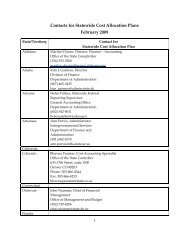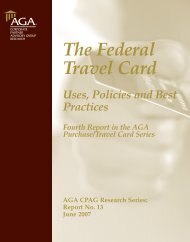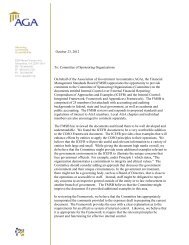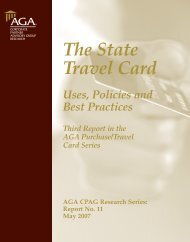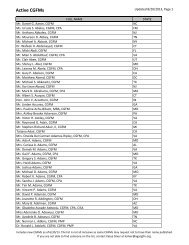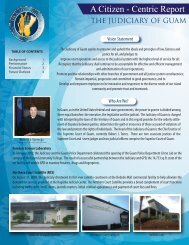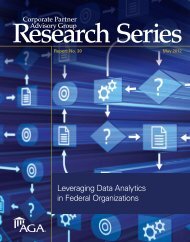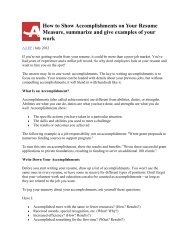speakers - AGA
speakers - AGA
speakers - AGA
Create successful ePaper yourself
Turn your PDF publications into a flip-book with our unique Google optimized e-Paper software.
Session W105 – Managing<br />
Third Party Providers
Speakers<br />
• Adam Goldberg, Department of the Treasury<br />
• Dennis Coleman, Office of Personnel<br />
Management<br />
• Tim Soltis, Department of Education
Office of Personnel Management<br />
Approach to Managing Third Party Vendors<br />
Presented By:<br />
DENNIS COLEMAN, CHIEF FINANCIAL OFFICER<br />
UNITED STATES OFFICE OF PERSONNEL MANAGEMENT
Topics<br />
• Background<br />
• Governance Structure<br />
• Relationship Overview<br />
• Commercial Vendor Governance<br />
• Oversight<br />
• Monitoring<br />
• Federal SSP Governance<br />
• Oversight and Monitoring<br />
• Conclusion<br />
• Contact Information
Background<br />
• OPM’s Blended Approach<br />
• Procurement of Commercial Systems Integrator<br />
in July 2008<br />
• Deployment of modernized Core accounting<br />
system in October 2009<br />
• Transition of AP Invoice and Disbursement<br />
Processing to Federal SSP in January 2013
Governance Structure<br />
• OPM Project Lead<br />
• OPM Systems<br />
Lead<br />
Management<br />
Governance<br />
• Systems Integrator,<br />
Commercial<br />
Vendor<br />
• Federal Shared<br />
Service Provider<br />
• OPM Executive<br />
Steering<br />
Committee<br />
• Government<br />
Executive Sponsor<br />
Execution<br />
OPM Executive Steering Committee – Made up of<br />
OPM Senior Executives<br />
Government Executive Sponsor – OPM, Chief<br />
Financial Officer<br />
OPM Project Lead - Works in partnership with<br />
systems integrator and Federal SSP on the overall<br />
project and its deliverables<br />
OPM Systems Lead – Responsible for managing<br />
the CBIS system.<br />
Federal Shared Service Provider – Responsible for<br />
OPM invoice processing<br />
Systems Integrator – Commercial Vendor<br />
responsible for IT hosting and administration,<br />
application management services and system<br />
implementation services for CBIS.
Relationship Overview<br />
Governance,<br />
Oversight &<br />
Monitoring<br />
IT Hosting &<br />
Administration<br />
Application<br />
Management<br />
Services<br />
System<br />
Implementation<br />
Services<br />
Business<br />
Transaction<br />
Processing<br />
OPM Chief<br />
Financial Office <br />
Systems Integrator<br />
(Commercial) <br />
Shared Service<br />
Center (Federal)
Commercial Vendor Governance<br />
Oversight<br />
• Agency Director-Endorsed Executive Steering Committee<br />
• Project Management Office<br />
• Quality Management Plan / Quality Assurance Evaluations<br />
(QAE)<br />
• Operational Level Agreement (OLA)<br />
• Service Level Agreement (SLA)<br />
• Authorization & Accreditation (A&A) and continuous monitoring<br />
for Security Assessments with dedicated DSO<br />
• SSAE16 (formerly SAS70) obtained as part of initial award
Commercial Vendor Governance<br />
Monitoring<br />
• CFO Executive Review Meetings<br />
• Investment Review Board (IRB)<br />
• Capital Investment Committee (CIC)<br />
• Change Control Board (CCB)<br />
• Team Core Status Meetings<br />
• Deliverables Management<br />
• Earned-Value Management (EVM) Reports
Federal SSP Governance<br />
Oversight and Monitoring<br />
• CFO Executive Review Meetings<br />
• Site visits<br />
• Recurring Status Meetings<br />
• Standardized Metrics<br />
• Prompt Payment<br />
• Cost Utilization Reports<br />
• Audit Reviews<br />
• Central CFO Correspondence E-mail Box<br />
• Earned-Value Management (EVM) planned for the future
Governance Framework
Conclusion<br />
• Lessons Learned<br />
• Use of hybrid shared service partnerships and a<br />
talented analytical workforce to deliver<br />
comprehensive work products cost effectively<br />
• Development of mutual performance indicators or<br />
standards between Agency and Vendor and Agency<br />
and Federal SSP<br />
• Phased approach to transition of any/all services<br />
• Benefits to using EVM to manage and control<br />
Federal SSP
Contact Information
Selecting and<br />
Monitoring a<br />
Shared Service<br />
Provider<br />
Tim Soltis<br />
Department of<br />
Education
Agenda<br />
• Entity Mission Objectives<br />
• Phased Approach to Shared Services<br />
• Factors to Consider<br />
• Inventory Current Services<br />
• Identify Feasible Shared Service Candidates<br />
• Recommended Course of Action<br />
• Recommended Conversion Strategy<br />
• Establish and Monitor Service Level Agreement<br />
• Common Issues and Impediments<br />
• Success Factors
SHARED SERVICES<br />
Shared Service<br />
Definitions<br />
Entity<br />
Mission<br />
Objectives<br />
Customer<br />
perspective<br />
Obtain costeffective<br />
and quality<br />
services consistent<br />
with organizational<br />
mission objectives<br />
Federal<br />
Shared<br />
Service<br />
Provider<br />
(FSSP)<br />
17
Phased Approach to Shared Services<br />
Data Source: Executive Office of the President - Federal Information Technology Shared<br />
Services Strategy - May 2012 18
Good Reasons<br />
•OMB Mandate –Consider<br />
shared solutions for future IT<br />
modernization efforts<br />
•Aligns with entity strategic<br />
goals and objectives<br />
•Achieves benefits such as:<br />
o Lower costs<br />
o<br />
Reduced complexity of<br />
business processes<br />
o Improved/more<br />
predictable data quality<br />
•Addresses other challenges<br />
such as:<br />
o Hard to hire /sustain staff<br />
o<br />
o<br />
Heavy reliance on<br />
contractors<br />
Rapidly changing<br />
technology<br />
Factors to Consider<br />
Not‐So‐Good Reasons<br />
•Everyone else is doing it<br />
•Service provider will fix<br />
problems<br />
•Avoid the need for a<br />
reorganization or personnel<br />
changes<br />
•Advances in technology<br />
alone in business segment<br />
o Technology should be<br />
seen as a mission enabler<br />
19
Inventory Current<br />
Services<br />
1. Define<br />
business<br />
operations<br />
into horizontal<br />
lines of<br />
business 2. Break lines of<br />
business into<br />
specific activities<br />
and identify:<br />
• Organizations and people<br />
• Legacy systems and interfaces<br />
• Manual processes<br />
• Other related activities<br />
3. Determine<br />
Resource<br />
Requirements<br />
• Identify cost drivers<br />
4. Determine<br />
Performance<br />
Requirements<br />
5. Identify<br />
known<br />
deficiencies<br />
• Current performance metrics<br />
• Define acceptable level of<br />
service<br />
• Identify related must‐have<br />
requirements<br />
20
Identify Feasible Shared Service Candidates<br />
Identify list of best shared<br />
service candidates<br />
• Don’t try to “boil the<br />
ocean” –focus on the<br />
best feasible candidates<br />
and seek win‐win<br />
Involve key stakeholders<br />
• Listen and act on valid<br />
concerns<br />
• Avoid parochialism<br />
Benchmark against other<br />
Federal organizations<br />
• Focus on success stories and<br />
details of execution<br />
• Lessons learned<br />
21
Recommended Course of Action<br />
Identify potential matches<br />
• Fully understand service provider capabilities and past performance (‘track record’)<br />
• Ensure service provider understands your requirements and expectations<br />
• Determine the extent of internal change required and willingness to change<br />
Narrow list to most suitable candidates<br />
• Select best win‐win situation<br />
• “Red team” potential issues and concerns<br />
Build the business case to support the decision<br />
• Be fully transparent about risks, costs and intended benefits<br />
• Fully document the “is‐is” and proposed “to‐be” models<br />
o Define impact on people and organizational structure<br />
o Identify changes in the budget<br />
• Define change management requirements<br />
o Get leadership support and stakeholder buy‐in<br />
• Make go/no‐go decision<br />
• Identify accountable officials<br />
22
SHARED SERVICES<br />
Recommended Conversion Strategy<br />
1<br />
Develop detailed implementation plan with timelines<br />
2<br />
Appoint implementation team and establish governance process<br />
3<br />
Establish budget – reallocate funds as needed<br />
4<br />
Execute plan<br />
5<br />
Implement change management and communication plans<br />
6<br />
Monitor transition progress and post-implementation performance<br />
7<br />
Ensure intended benefits are realized<br />
23
Establish Service Level Agreement (SLA)<br />
• Negotiate Terms of Agreement – Agreement<br />
should define the following:<br />
• Customer requirements – level of service, quality, and<br />
other expectations<br />
• Interoperability requirements – open standards<br />
• Costs and funding requirements<br />
• Audit expectations (SSAE16)<br />
• Performance standards (range, if appropriate)<br />
• Period of performance<br />
• Governance and dispute resolution process<br />
• Sign Agreement<br />
24
Monitor Service Level Agreement (SLA)<br />
• Active Management<br />
• Assign accountability – contractual perspective<br />
• Communicate regularly – consider on-site presence<br />
• Hold service provider to terms of agreement<br />
• Resolve issues quickly or elevate them<br />
• Consider evolving requirements<br />
• Other Considerations<br />
• Transition support requirements<br />
• Retain knowledge of entire business process<br />
• Have an exit strategy<br />
25
Customer<br />
People<br />
Internal processes<br />
Organizational<br />
structure<br />
Data<br />
System Architecture<br />
Legacy systems<br />
Interfaces/controls<br />
Data standards<br />
Approach to changing<br />
technology<br />
Common<br />
Issues and<br />
Impediments<br />
Service Provider<br />
Quality<br />
Costs<br />
Transparency<br />
Adaptability<br />
Governance<br />
Audit requirements<br />
Dispute resolution<br />
Metrics<br />
Achieving intended<br />
benefits<br />
26
SHARED SERVICES<br />
Success Factors<br />
• Pick the right team –“win‐win”<br />
• Customer support/continuous improvement culture<br />
• Tone at the top with cascaded accountability<br />
• Robust governance<br />
• Performance monitoring/dispute resolution<br />
• People first strategy in change management<br />
• Communicate with staff and stakeholders<br />
27
Q&A



